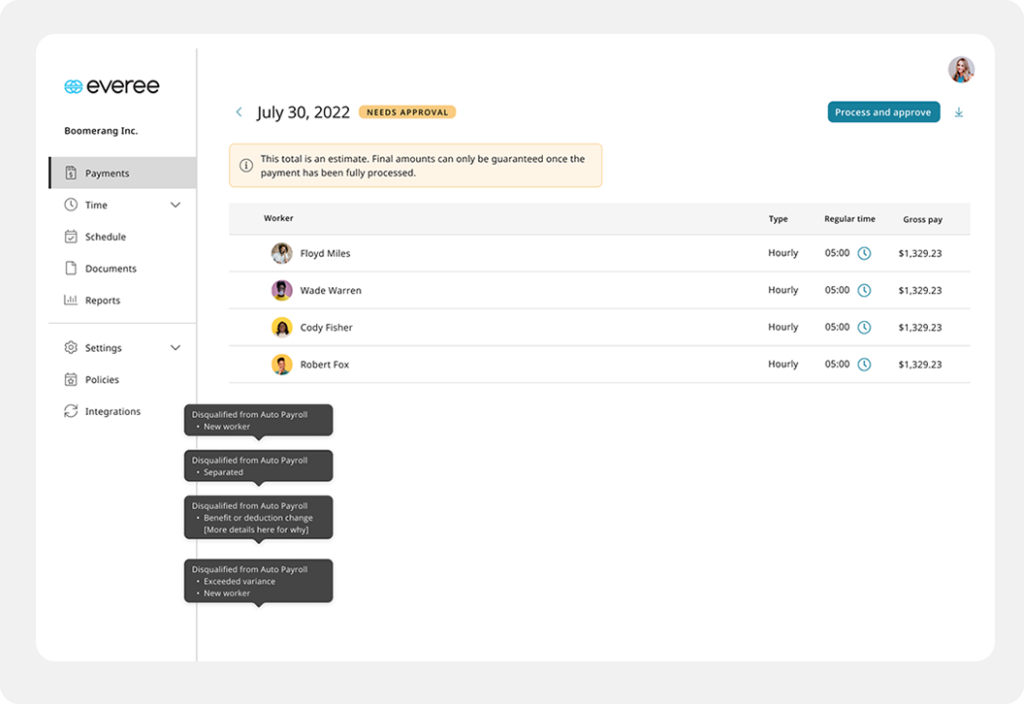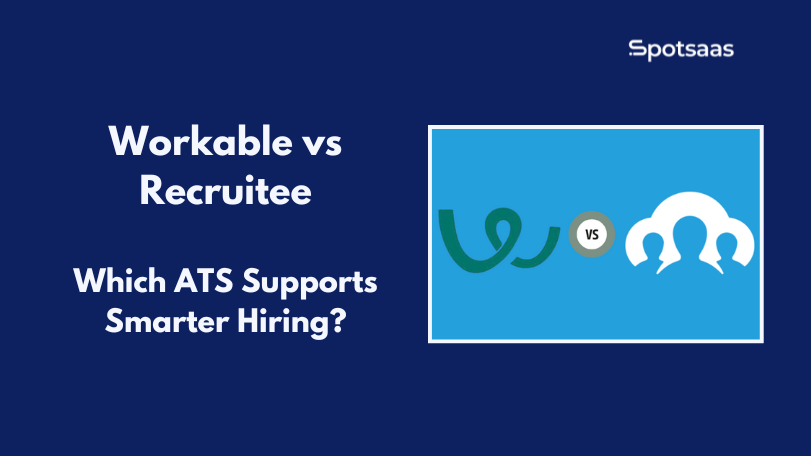Choosing the right database model is crucial for balancing data consistency, availability, and scalability. The ACID model ensures strict reliability and is ideal for financial transactions and enterprise applications.
In contrast, the BASE model prioritizes scalability and high availability, making it suitable for distributed systems and big data applications. Understanding the strengths and trade-offs of ACID vs. BASE databases can help you optimize performance for your specific use case.
This guide will explore key differences, real-world use cases, and future database technology trends.
Key Takeaways
- ACID databases ensure strict consistency and reliability, making them ideal for financial and transactional applications.
- BASE databases prioritize scalability and availability, making them suitable for distributed and real-time systems.
- The trade-off between consistency and performance determines the best database model for a given use case.
- Hybrid approaches like NewSQL aim to combine the strengths of both ACID and BASE models for modern applications.
ACID Model vs. BASE Model for Databases
The ACID and BASE models are two transactional models used in databases that differ in their consistency, availability, and scalability approach.
What is the ACID Model?
The ACID model is a fundamental principle in database management systems that ensures data integrity and consistency during transactions.
It is widely used in relational databases where maintaining accuracy and reliability is critical. ACID stands for atomicity, consistency, isolation, and durability, each of which plays a vital role in database transactions.
Understanding the ACID Properties

Atomicity
Atomicity ensures that a transaction is all or nothing. If any part of the transaction fails, the entire operation is rolled back, preventing partial updates that could lead to inconsistent data.
Example: In an online banking system, if a customer transfers money between two accounts, the database must ensure that both debit and credit transactions are successful. If one fails, the other must be undone to prevent an incorrect balance.
Consistency
Consistency ensures that the database remains valid before and after a transaction. Transactions must follow predefined rules and constraints to prevent corrupt or invalid data from being stored.
Example: In an e-commerce system, if an order is placed, the stock count must be updated. A transaction that allows stock to go below zero would violate consistency and should be rejected.
Isolation
Isolation ensures that concurrent transactions do not interfere with each other, preventing data conflicts and ensuring that each transaction executes independently.
Example: When multiple users try to purchase the last available product in an online store, isolation ensures that only one user successfully completes the transaction, preventing duplicate orders.
Durability
Durability guarantees that once a transaction is committed, it remains permanently stored in the database, even in system failures or crashes.
Example: If a customer successfully places an order on an e-commerce platform and the server crashes afterward, the order details should still be available when the system restarts.
What is the BASE Model?
The BASE model is an alternative approach to database management that prioritizes scalability, availability, and fault tolerance over strict consistency.
It is widely used in distributed and NoSQL databases, where performance and uptime are more critical than immediate data accuracy. BASE stands for Basically Available, Soft State, and Eventually Consistent, each defining how transactions operate in these systems.
Understanding the BASE Properties
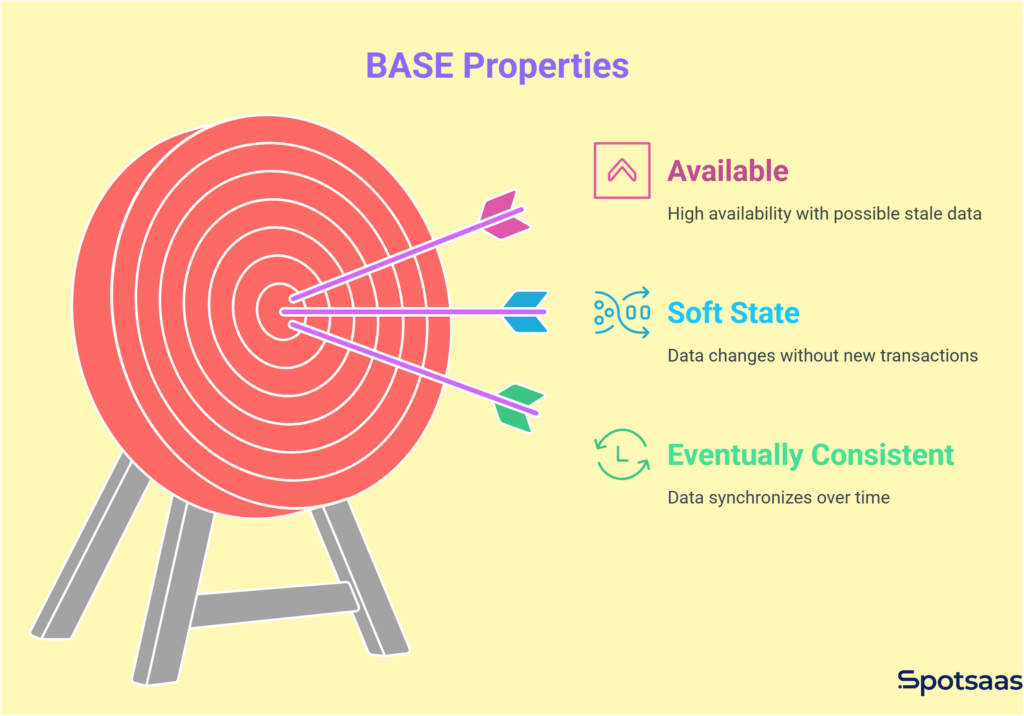
Available
The system guarantees high availability, ensuring that database operations always return a response, even if some data is outdated or missing due to temporary inconsistencies.
“In a social media platform like Twitter, a newly posted tweet may immediately appear on the user’s timeline, but it may take a few seconds before it is fully replicated across all servers and visible to all followers.”
Soft State
Data can change or be updated over time, even if no new transactions occur. Unlike ACID systems, BASE does not assume the database is always in a strict, fixed state.
“In an online shopping platform like Amazon, product availability may fluctuate across different regions due to replication delays, meaning one server may show an item as ‘in stock’ while another shows it as ‘out of stock.'”
Eventually Consistent
The BASE does not enforce immediate consistency across all nodes but ensures that the data synchronizes and becomes consistent over time. This allows databases to scale horizontally without strict locking mechanisms.
“In an online chat application like WhatsApp, when a message is sent, it may appear instantly on the sender’s screen, but due to network delays, it may take a moment before the recipient sees it, ensuring eventual consistency rather than immediate synchronization.”
ACID vs. BASE Database Key Differences
ACID ensures strong consistency and reliability, making it ideal for transactional systems, while BASE prioritizes scalability and availability, which is best suited for distributed applications.
The table below highlights the core differences between these two models.
| Feature | ACID Model | BASE Model |
|---|---|---|
| Data Consistency | Strong, immediate | Eventual (can be delayed) |
| Performance | Slower due to strict rules | Faster due to relaxed constraints |
| Scalability | Harder to scale | Easily scalable (distributed) |
| Availability | Limited (focuses on consistency) | High (focuses on uptime) |
| Failure Handling | Rolls back transactions on failure | Tolerates partial failures |
| Best for | Banking, healthcare, e-commerce | Social media, analytics, cloud apps |
Use Cases for ACID Databases
ACID databases are essential for applications where data accuracy, consistency, and reliability are critical. They ensure that transactions are fully completed or rolled back, preventing data corruption and maintaining integrity. Below are some key areas where ACID databases play a crucial role.
Banking and Financial Systems
Financial applications require consistency to avoid duplicate transactions, data loss, or incorrect balances. Transactions in banking systems must be atomic, ensuring that money transfers, withdrawals, and payments are either fully processed or not executed at all.
Healthcare and Medical Records
Medical databases store sensitive patient information that must be protected from data loss or inconsistencies. ACID properties ensure that updates to patient records, prescriptions, and test results are correctly stored and cannot be partially written due to system failures.
E-commerce Payment Processing
E-commerce platforms rely on ACID compliance to prevent duplicate charges, inventory errors, and incomplete orders. Payment transactions must be executed as a complete process, ensuring that stock levels are updated, payments are processed correctly, and customers receive order confirmations.
Enterprise Resource Planning (ERP) Systems
ERP software integrates finance, supply chain, human resources, and business operations. ACID compliance ensures that changes made in one module reflect consistently across all linked systems, preventing discrepancies in financial reports, payroll processing, and inventory management.
Airline Reservation and Ticketing Systems
Airline booking systems handle many simultaneous transactions, requiring consistency to prevent overbooking and incorrect seat allocations. ACID ensures that once a seat is reserved, it is immediately reflected in the system, avoiding multiple bookings for the same seat.
Government and Legal Records Management
Government databases store legal documents, tax records, and identity information that must be permanently accurate and tamper-proof. ACID compliance ensures that once data is recorded, it cannot be lost or partially updated due to system failures, maintaining compliance with legal standards.
Use Cases for BASE Databases
BASE databases are designed for applications that prioritize scalability, availability, and performance over strict consistency.
They are widely used in distributed systems, NoSQL databases, and large-scale applications where eventual consistency is acceptable. Below are key areas where BASE databases are commonly applied.
Social Media Platforms
Social networks require high availability and the ability to handle massive amounts of data in real-time. BASE databases allow users to post content, like posts, and comment instantly while synchronizing data across multiple servers over time.
Streaming Services
Online video streaming platforms must deliver fast content access without waiting for full synchronization. BASE databases enable smooth playback while syncing user watch history, recommendations, and analytics in the background.
E-commerce and Online Marketplaces
Large-scale e-commerce platforms use BASE databases to ensure fast product searches, real-time price updates, and high availability. Shopping carts, product recommendations, and inventory updates work asynchronously to provide a seamless user experience.
Internet of Things (IoT) Applications
IoT systems generate massive amounts of data from sensors and devices that must be processed and stored quickly. BASE databases support real-time data ingestion and processing while synchronizing across distributed networks.
Real-Time Analytics and Big Data Applications
Applications handling large volumes of data, such as financial market analysis, fraud detection, and machine learning, rely on BASE databases for real-time data processing. These systems prioritize availability and speed, allowing insights to be generated on live data streams.
Content Delivery Networks (CDNs)
Websites and applications that serve content globally use BASE databases to distribute and cache data across multiple locations. This allows users to access content faster, even if updates to the underlying data are still propagating across servers.
Multiplayer Online Games
Massively multiplayer online games (MMOs) and real-time gaming platforms require low latency and high availability. BASE databases help manage in-game transactions, player interactions, and game state updates while ensuring performance across multiple players worldwide.
Challenges In ACID Vs. Base Databases
ACID and BASE databases have advantages and trade-offs, making them suitable for different applications.
ACID databases prioritize strict consistency and reliability, making them ideal for transactional applications, while BASE databases focus on scalability and availability, which is useful for distributed systems. Understanding each model’s challenges helps select the database for a specific use case.
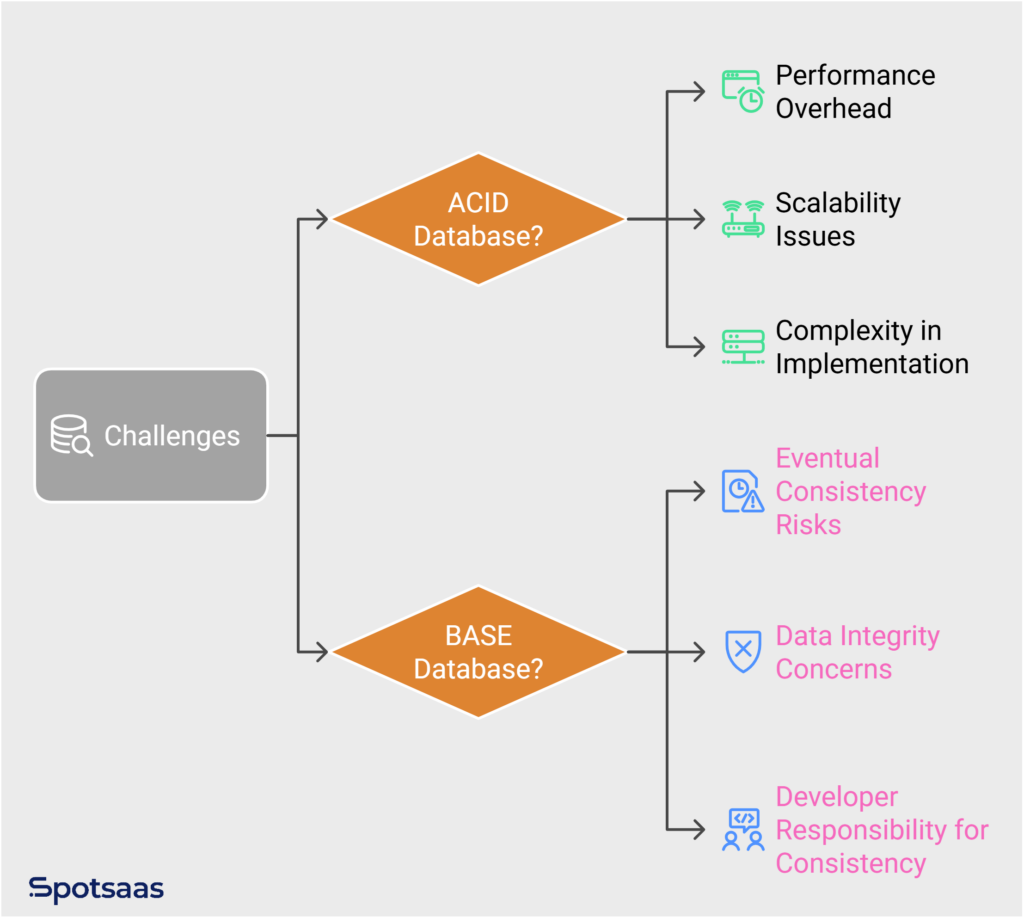
Challenges of ACID Databases
ACID databases offer strong consistency and data integrity but come with performance overhead, scalability limitations, and implementation complexity. These challenges make them less suitable for large-scale distributed systems that prioritize availability.
Performance Overhead
ACID-compliant transactions require additional processing steps, such as locking mechanisms and rollback procedures.
These steps slow down transaction speeds, making ACID databases less suitable for applications that demand real-time responsiveness. High transaction volumes can lead to significant execution delays.
Scalability Issues
ACID databases are typically designed for single-node or vertically scaled systems, meaning they struggle with horizontal scaling across distributed environments.
Maintaining consistency across multiple servers requires complex coordination, which can be a bottleneck in cloud-based and global applications. As data volume grows, scaling an ACID database requires additional infrastructure and careful optimization.
Complexity in Implementation
Ensuring ACID compliance requires strict control over transactions, locking, and rollback mechanisms, making database management more complex.
Developers and database administrators must carefully design schemas, manage isolation levels, and optimize query performance to avoid deadlocks. This complexity increases development time and maintenance costs.
Challenges of BASE Databases
BASE databases are optimized for scalability and availability but come with eventual consistency risks, data integrity concerns, and added developer responsibility. These trade-offs require careful management to avoid potential pitfalls.
Eventual Consistency Risks
BASE databases prioritize availability over consistency, meaning updates are not immediately synchronized across all nodes.
This can lead to temporary discrepancies, where users see outdated or inconsistent data before synchronization completes. In applications requiring real-time accuracy, this delay may cause incorrect information to be displayed.
Data Integrity Concerns
BASE databases are unsuitable for applications requiring high accuracy, such as banking, healthcare, or legal records management.
Since consistency is relaxed, data may briefly exist in an incomplete or conflicting state, increasing the risk of data anomalies. Poorly managed inconsistencies could lead to incorrect transactions or unreliable data reporting.
Developer Responsibility for Consistency
Unlike ACID databases, where consistency is handled at the database level, BASE databases shift the responsibility to developers, requiring custom logic to resolve data conflicts, handle retries, and ensure eventual consistency.
This increases development complexity and demands additional safeguards to prevent data corruption or inconsistencies across multiple system instances.
When to Use ACID vs. BASE
Choosing between ACID and BASE databases depends on an application’s specific needs. ACID databases prioritize data integrity and reliability, making them ideal for transactional systems, while BASE databases focus on scalability and availability, making them suitable for distributed applications.
Choosing an ACID Database
ACID databases are best suited for applications that require strict accuracy and reliability. They ensure that transactions are processed correctly every time and help maintain strong data integrity, preventing errors that could compromise business operations or regulatory compliance.
Data consistency is critical.l
Applications such as banking, medical records, and legal document management rely on accurate and up-to-date information, where minor inconsistencies can cause significant issues. In these systems, data errors could lead to financial losses, medical misdiagnoses, or legal disputes.
Transactions must be 100 percent reliable.le
E-commerce payments, inventory management, and enterprise systems require precise transactional control to prevent duplicate charges, incorrect stock updates, or financial discrepancies.
Without ACID compliance, customers could be overcharged, businesses could lose track of stock, and enterprise operations could suffer inefficiencies.
Slower performance is acceptable for high accuracy
In industries where correctness is more important than speed, ACID databases provide strong data integrity, ensuring that operations are executed precisely, even if they take longer. This trade-off is acceptable in applications like financial systems, where delays are preferable to incorrect transactions.
Choosing a BASE Database
BASE databases are ideal for applications that require high availability and scalability.
They allow fast data access even if immediate consistency is not guaranteed, making them well-suited for large-scale, distributed environments that handle massive amounts of data with minimal downtime.
High scalability and availability are required.
Social media platforms, recommendation engines, and cloud-based applications serve millions of users simultaneously, requiring a database model that can efficiently scale without strict consistency constraints.
These databases allow businesses to handle sudden spikes in traffic without system failures or slowdowns.
Temporary inconsistencies are acceptable.
Applications where data synchronization delays do not significantly impact the user experience, such as online marketplaces, content delivery networks, and distributed caching systems, benefit from the flexibility of BASE databases.
Minor delays in displaying the latest updates are acceptable if the system remains responsive and available.
Real-time responsiveness is more important than strict consistency
Streaming services, multiplayer gaming, and real-time analytics applications need fast access to data, prioritizing performance over immediate consistency to ensure seamless user experiences.
Users expect uninterrupted interactions, even if the most recent changes take a few moments to synchronize across all servers fully.
Future Trends in Database Models
As databases evolve, they adapt to meet the demands of scalability, automation, and decentralization. Key trends include hybrid models, AI-driven databases, edge computing, and blockchain-based solutions, enhancing efficiency and adaptability.
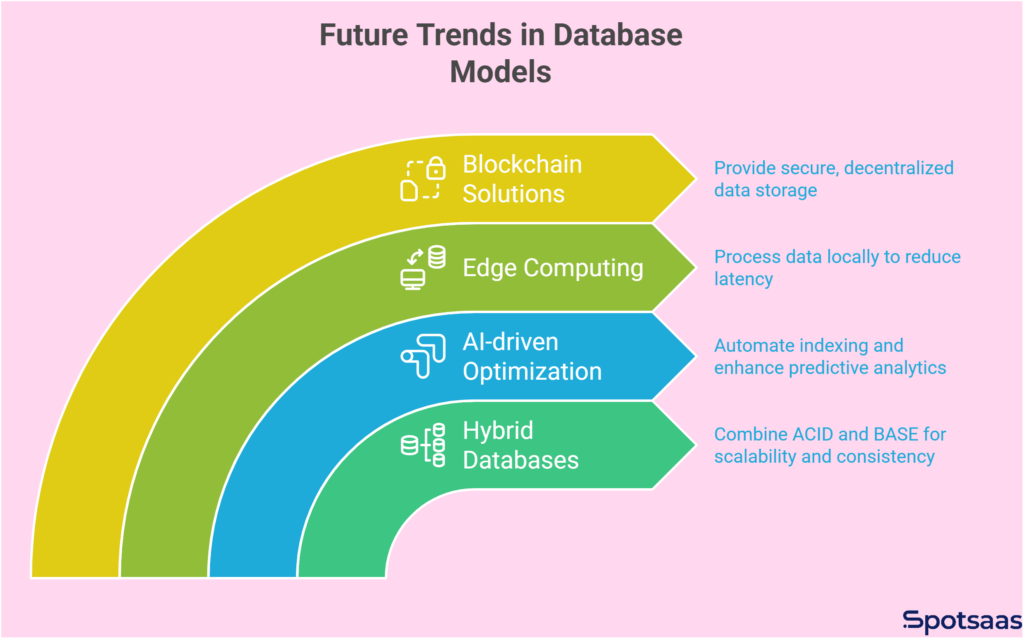
Hybrid databases for scalability and consistency
NewSQL and distributed SQL databases combine the benefits of ACID and BASE, offering strong consistency while supporting high scalability and distributed processing.
These models ensure transactional integrity across multiple locations without the performance bottlenecks of traditional ACID databases. Hybrid databases are widely used in cloud-native applications, financial services, and global enterprises where both availability and reliability are crucial.
AI-driven database optimization
Artificial intelligence and machine learning are critical in database management, query optimization, and anomaly detection. AI-driven databases automate indexing, optimize query performance, and detect inconsistencies, reducing the need for manual tuning and maintenance.
Self-learning databases also improve predictive analytics, fraud detection, and real-time decision-making in the healthcare, finance, and e-commerce sectors.
Edge computing for faster processing
As real-time applications and IoT devices grow, databases shift toward localized data processing to minimize latency and improve speed. BASE-like models are being adapted to edge computing environments, allowing data to be processed closer to the source instead of relying on centralized servers.
This approach enhances performance in autonomous vehicles, industrial automation, smart cities, and mobile applications where instant data access is required.
Blockchain databases for secure storage
Blockchain-based databases introduce tamper-proof, decentralized data storage with ACID-like guarantees, improving security and transparency.
These databases enable trustless transactions, data immutability, and enhanced privacy, making them ideal for applications in finance, digital identity management, supply chain tracking, and smart contracts.
As blockchain technology matures, more industries integrate decentralized storage solutions to improve security, compliance, and data integrity.
Real-world Applications of ACID and BASE
ACID and BASE databases are used in real-world applications based on their unique strengths.
ACID databases are preferred in scenarios where data integrity and transaction reliability are crucial, while BASE databases are used in applications that require high scalability and availability with minimal latency.
How ACID Works in the Real World
ACID databases are used in industries where accurate and consistent transactions are essential. They ensure every operation is fully completed or rolled back, preventing errors and inconsistencies.
Banking Systems
Financial institutions rely on ACID databases to ensure accurate transactions and prevent inconsistencies in customer accounts. ACID compliance ensures that funds are correctly debited and credited when transferring money between accounts, avoiding duplicate transactions or lost funds.
E-commerce Payments
Online retailers use ACID databases to process payments securely and manage inventory accurately. When a customer orders, the system ensures the payment is processed successfully before updating the stock levels, preventing overbooking or double charging.
How BASE Works in the Real World
BASE databases are widely used in applications that require fast performance, large-scale data distribution, and high availability.
These systems prioritize user experience, ensuring smooth interactions even when data consistency is slightly delayed.
Netflix and YouTube
Streaming platforms use BASE databases to handle millions of concurrent users, ensuring that video content loads instantly while personalized recommendations and watch history updates sync in the background. This approach improves performance without delaying playback.
Amazon and eBay
Large e-commerce platforms like Amazon and eBay use BASE databases to provide millions of users with real-time product availability, pricing updates, and search results. These platforms prioritize availability to ensure seamless browsing and ordering experiences, even during peak traffic.
Conclusion
Choosing between ACID and BASE databases depends on the application’s needs. ACID databases focus on data integrity and reliability, making them ideal for banking, healthcare, and financial transactions. BASE databases prioritize scalability and availability, making them suitable for social media, streaming services, and real-time analytics.
Many modern databases combine elements of both models to achieve both consistency and scalability.
As technology evolves with AI-driven databases, edge computing, and blockchain, database management will become more efficient and adaptable. Selecting the right model depends on balancing consistency, availability, and performance for specific use cases.
Frequently Asked Questions
What are ACID and BASE databases used for?
ACID databases are used for applications requiring strict data consistency, such as banking, healthcare, and financial transactions.
BASE databases are used in applications that require high availability and scalability, such as social media, streaming services, and e-commerce.
Why do ACID databases perform slower than BASE databases?
ACID databases follow strict transaction rules, ensuring consistency and integrity, which requires additional processing time.
BASE databases relax these rules, prioritizing availability over immediate consistency and allowing faster performance.
Are BASE databases reliable for financial applications?
No, BASE databases are not ideal for financial applications because they do not guarantee immediate consistency. Financial systems require precise transactions where errors or delays can lead to incorrect balances or duplicate transactions.
What are the biggest challenges of using ACID databases?
ACID databases have performance overhead, are challenging to scale horizontally and require complex transaction management, making them less efficient for distributed systems that handle high volumes of data.
How do hybrid databases combine ACID and BASE principles?
Hybrid databases, such as Google Spanner and CockroachDB, integrate ACID consistency with BASE scalability, allowing applications to maintain data integrity while ensuring high availability and performance across distributed systems.


